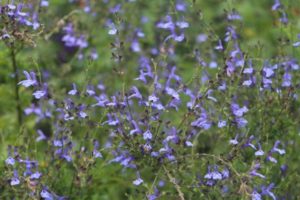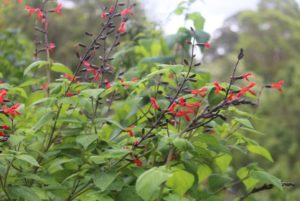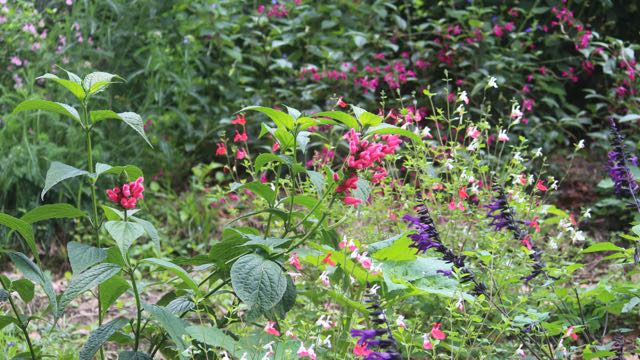Salvia cultivation overall tends to be straightforward. They are on the whole undemanding plants with a few pests and a few basic needs. There are a few generalisations that can be made. As a group, they tend to like deep, well drained soil, and are not overly fussy about pH or soil nutrients. Of course the more you get to know them the more you see that they are a diverse group and have a matching range of optimal growing conditions, which you can use to your advantage in siting them in the garden.
Rainfall for salvia cultivation

One main division in salvia cultivation is between the ‘Mediterranean’ type salvias, which like dry Summers and wet Winters, and the ‘Subtropical’ salvias which prefer wet Summers.
The Mediterranean salivas often have hairy grey leaves, and the culinary sage Salvia officinalis is the archetype. Culinary sage doesn’t cope with our wet Summers here, and by contrast is a very tough and long-lived plant in Summer-dry Perth where it sends roots way down into the sandy soil. Here, and right along the East coast of Australia, we grow Salvia officinalis in pots, ideally under North-facing eaves where it can get sunshine, perfect drainage, and little rain.
The subtropical salvias tend to come from the Americas, and while they like deep, well drained soils, they do fine with wet and humid Summers and Autumns. Conversely, most appreciate drier conditions through Winter. Here we tend to have a rainless spell sometime in late Winter to Spring, and the soil profile can dry right out to spade depth, but established salvias hold on fine. There are a few exceptions that I will list below.
Many of the subtropical type salvias come from mountain ranges where they experience frequent mist. Here I have noticed that the minutely hairy leaves collect a fair amount of water on our frequently misty nights, and I wonder how much it can supplement their water supply when rain is scarce.
Temperature
Another major division of salvia cultivation is between frost tolerant and frost tender salvias. This is a central issue for salvia growers who live with frost, and gardeners in Europe and North America tend to take cuttings to over-winter in greenhouses, and sow or buy new plants in Spring.
Many salvias come from frost-prone areas and so either die down to rootstock in Winter, or are nipped and come again from stems. As we don’t get frost here we have the luxury of leaving our salvias in the ground year-round, so I’ll leave the expert first hand advice of over-wintering salvias to others. Some websites have very useful information about how frost hardy individual salvias are.
Sun

There are salvias for sun and shade. For salvia cultivation I find leaf size to be a good guide; salvias with larger dark green leaves like madrensis, confertiflora, and gesneriflora, do best in part shade. Purple undersides to the leaf are also an indicator of shade tolerance or preference. Some, like miniata and dombeyi must have shade. Most salvias though grow best in full sun but are very tolerant of some shade.
Local experience is important for finding the best position for some salvias. Salvia ‘Van Houttei’ grows best in full sun in northern climates such as England, but here it wilts in the intense sunlight of Spring, and grows well in shade. By contrast other cultivars derived from splendens such as the red bedding salvias or ‘Desley’ do well in full sun here.
I think that beyond the aspect of some leaves just plain burning in full sun, it is important to consider the corollaries of exposure in siting salvias. Full sun positions tend to be exposed to air movement, and so dry out during the day. A garden that is sheltered on all sides might present problems with fungal pathogens which are not encountered nearby in a more open garden.
Soil
With a few exceptions salvias will not tolerate wet feet, so free draining soil is possibly the critical aspect of culture. We are fortunate here that the soil drains extraordinarily for a heavy loam. By this I mean water doesn’t pool on the surface as you pour it from a watering can. This is important I think in our climate, as it can rain very heavily for hours; 300 mm in a day is not unheard of. Where clay comes close to the surface salvias don’t do so well.
As I mentioned at the top, salvias seem to be tolerant of other aspects of soil such as fertility and pH. Our soil has very low pH, around 5, which doesn’t seem to hamper growth. Salvias will grow in relatively poor soil, but better nutrition will promote faster growth, so if it’s important to get your plants off to a good start in Spring, then hop into the manure. Where you’re after flowers across the season, maybe go easy on nitrogen fertilizer to minimise leaf production.
Salvias that don’t cope well with dry conditions.
Splendens type salvias will wilt if the soil gets too dry. These are the red bedding salvias, as well as ‘Van Houttei’ and ‘Desley’. The other, blue, bedding salvia S. farinacea also suffers in dry conditions. The large-leaved salvias also prefer watering through drought, i.e. madrensis, gesneriflora, miniata, oxyphora, and dorisiana. S. oppositiflora, hirtella, and elegans will also go into dormancy at best.

